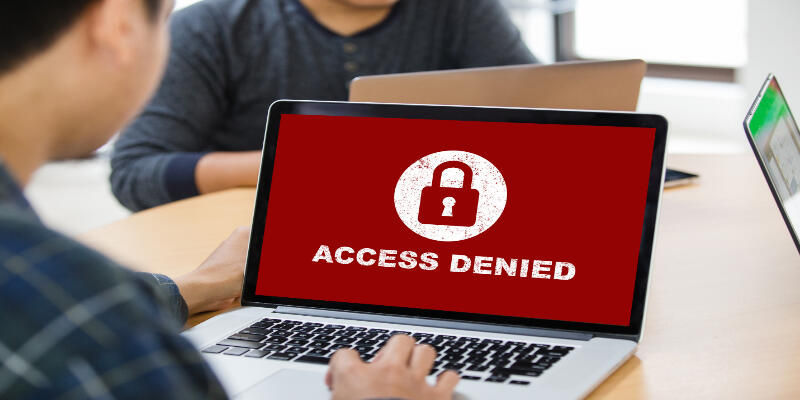Disclaimer: This post may contain affiliate links, meaning we get a small commission if you make a purchase through our links, at no cost to you. For more information, please visit our Disclaimer Page.
If you are trying to connect to your network but you get an error like this: “Denied Access to Network” you’re not alone.
One way to solve denied access to network error is to reset your phone. If the problem persists, ensure your phone’s time and date are correct and firmware is up to date. Should none of these fixes work, clear out the Wi-Fi data on your phone, reboot the router, and re-input the Wi-Fi data.
This article doesn’t just apply to phones, but to other devices as well having this issue. So read on to learn how to fix it!
Table of Contents
What Does Denied Access to Network Mean?
Take note, access to a network may be denied because of a faulty device or router. If none of the fixes I’d be sharing in this article works, then perhaps you should consider replacing some parts of your devices. It could be that something is faulty causing access to be denied.
When you are trying to connect to a network but you can’t access it for one reason or the other, you’d get a denied access to a network error message. This tells you that you do not have the appropriate authority to connect to the network.
Although this error is most often because of improper access rights, nevertheless, it can also be caused by a hardware error.
Although sometimes restarting your devices may fix this error, while other things you may need to do a complete replacement of the hardware.
Except you are familiar with the ins and outs of your router and device we do not recommend you fix this yourself. Contact a certified network engineer to fix hardware problems if you are a novice.
What Are the Causes of Denied Access to Network Error?
Access denied to a network is an error that can be caused by several reasons. From my experience dealing with this error, and what I’ve come to understand about it, here are what can cause this error:
MAC Address filtering Is Denying Access
Every device that connects to a network has a MAC address. The MAC addresses are also known as physical addresses and they are used to hold logical addresses called IP addresses.
The IP address is what is used to locate network devices for receiving and sending network traffic. Now if the MAC address of your device is blocked from the network by those who own the router, then you wouldn’t be able to access the network.
Network Is Full
Each access point or router has a maximum number of devices that can connect to it at a time. If a router’s DHCP pool has no remaining IP addresses that can be assigned, then you will not be able to get an IP address.
Therefore, you will be denied access. Lower-end routers are commonly associated with this problem as they have few IP addresses in their DHCP address pool.
Router Bandwidth Limitation Is Activated
Most routers support bandwidth limitations. Limiting the bandwidth of a router prevents over flooding the router which can slow down the speed by a great number.
If a router has bandwidth limitation activated, it may be the cause why you can’t access the network. So, even though there may be available addresses in the DHCP address pool, if the bandwidth allocation is at full capacity, you wouldn’t be able to access it.
The Router Is Incompatible With Your Device
Importantly if your device isn’t compatible with the router, this will disallow access. For example, let’s consider the 2.4GHz and 5GHz network options.
While most devices support the 2.4GHz network option and can easily connect to it, but some devices wouldn’t recognize the 5GHz network option, let alone connect to it.
The device is sending an incorrect network keycode
A network keycode is better known as the Wi-Fi password. Sometimes, access to a network is denied because your device is sending an incorrect keycode.
For example, if the password of a network has upper and lower cases, and you type it perfectly, the device may not send it out appropriately.
It may first convert all the letters in the password to lowercase instead of leaving them in upper and lower case. And obviously, the router will read it as a wrong code and deny network access to that device.
You Are Not Typing The Keycode Correctly
Lastly, a router may be denying you access to a network when you do not type in the correct keycode.
Typing an incorrect keycode is the most common cause for denied access to a network.
If the password is missing a letter, a number, or you simply typed a lowercase when you should have typed an uppercase, access to the network will be denied.
How to Fix Denied Access to Network?
Only on rare occasions is denied access to network error a result of faulty hardware. Assuming none of your hardware is faulty, here are some fixes you can try to solve denied access to a network problem.
Restart your device
Restarting your device should be your first go-to fix when you encounter an error. If restarting your device doesn’t fix the MAC address error, then check the router, perhaps your MAC address has been blocked.
If your MAC address has been blocked, unblock it from the router settings. This can be done by accessing the router’s web page.
Disconnect Some Devices From The Router
If the DHCP address pool on the router is full, you wouldn’t be granted access to connect. To fix this, consider disconnecting some devices from the router.
This will free up space in the DHCP address pool so that the device you want to connect to the router can be assigned an IP address.
Deactivate Bandwidth Limitation
If you are still having denied access to network error, then check your router to confirm if bandwidth limitation is turned activated.
If bandwidth limitation is activated, it could be the cause of denied access to a network. Deactivate the bandwidth limitation and try connecting to the router again.
Consider Connecting To A Compatible Router
Sometimes, the reason you get denied access to a network may simply be because your device isn’t compatible with the router.
To solve this, consider using a different router that is compatible with your device, or a device that is compatible with the router.
Update Firmware
If your device keeps sending an incorrect network keycode to the router, updating your firmware should fix the problem. But if the problem persists, then consider getting a different device.
Confirm Password
A very common cause of denied access to a network is not typing a correct password. Maybe the password was changed or someone told you the wrong password.
To fix this, enable password visibility when typing the Wi-Fi keycode and verify it character by character. Also, ask the owner of the network to verify the password, and then try to establish the connection.
Conclusion
If after trying all the fixes suggested in this article and the problem persists, reset your device. Note, resetting your device clears all data on it. So, I suggest you use this option as a last resort and you don’t mind losing your data.
But be sure to back up your data to a cloud account or computer. Or better still if you are confused, leave a comment with the name of the device telling you access to network denied and what you have tried to fix it and I will guide you on how to fix it.


